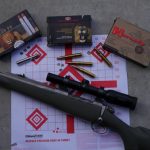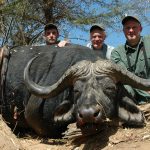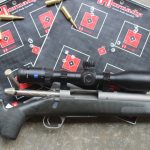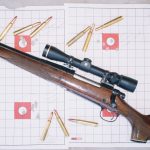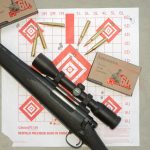Bonded, homogeneous alloy, tipped, low drag . . . how to sort through today’s confusing array of hunting bullets.
Before World War II, it was pretty simple: Expanding bullets were primarily simple copper-cup-and-lead-core bullets, expansion somewhat controlled by thickness of jacket, amount of lead exposed at the tip, and weight for caliber. For really large game, buffalo and upward, full-metal-jacket non-expanding “solids” were almost universal. Some folks, not trusting expanding bullets, used solids for everything. W. D. M. “Karamoja” Bell wrote of one his .275 Rigby rifles, that its barrel was never “polluted by the passage of a soft-point bullet.”
The Remington Core-Lokt came out in 1939, using mechanical features to reduce jacket and core separation. Nobody likes every bullet out there, but the Core-Lokt was and is a pretty darned good hunting bullet. John Nosler’s Partition (1948) is generally considered to be the first “premium” bullet, a dual-core bullet, with the front and rear cores separated by a wall of jacket material. In game, the front core expands quickly and some lead is wiped away, while the rear core acts like a mini-solid, often exiting. Many hunters like the exit wounds common with Partitions; others hate the loss of weight and the fact that recovered Partitions aren’t “pretty.” Again, nobody likes every bullet out there, but the Nosler Partition was—and is—a darned good hunting bullet.
Bonded Core
Bill Steigers’ Bitterroot Bonded Core (1965) was the first commercial bullet to chemically bond jacket to core. Core-bonding greatly reduced the lead core wiping away and jacket and core couldn’t separate. The Bitterroot retained more weight than was thought possible and quickly became a backwoods legend, but the bullets were virtually made by hand and hard to come by. Jack Carter’s Trophy Bonded Bearclaw bullet, developed in the late 1970s, performed marvelously, promising and delivering 95 percent weight retention. Carter’s bullet was much more available than the Bitterroot, and the legend grew. Federal began manufacturing the Bearclaw under license, and still does.
Today, core-bonding is common; Federal, Hornady, Norma, Nosler, and Swift, among others, offer bonded-core options. All bonded-cores are tough bullets that offer wide expansion, but retain much weight. Unique among them is the Swift A-Frame, which combines dual-core with core-bonding. The A-Frame probably offers the greatest weight retention of any lead-core bullet, with some of the widest expansion. The A-Frame is fantastic for any large game that should be hunted with an expanding bullet. If it has any downsides, it is an expensive bullet to make (and buy), and is “medium” in aerodynamics.
Homogeneous Alloy
The Barnes X, developed by Randy Brooks in about 1985, was the first copper alloy expanding hunting bullet. Copper fouling and pressure spikes were minor issues, both greatly alleviated by the TSX (Triple Shock X) with engraved driving bands. Hornady’s GMX followed, along with Nosler’s E-Tip, Federal’s Trophy Copper, and many more.
Although copper alloys differ, as do width and depth of nose cavity, but all of these bullets work similarly: Upon impact, the skived (serrated) nose peels back in petals. It is always possible for a petal (or two) to break off, and expansion is limited by depth of nose cavity. Expansion is not as wide as most lead-core bullets, but if all petals remain intact, weight retention can approach 100 percent.
The “copper” bullets are penetrating bullets. Exit wounds are likely (which many hunters prefer). The opposite theory, of course, is that any bullet that exits an animal expends (“wastes”) energy on the far side. No bullet can please everybody!
Wound channels are often not as wide as lead-core bullets because there is less expansion. Today many hunters swear by these bullets and, in “lead free” areas, these are what we must use. No question, they work! My unedited opinion is that, in a perfect world, these bullets are tougher than necessary for smaller game, but really come into their own on animals larger than deer. As with any type of bullet, some barrels shoot them very well, but some do not.
Tipped
With all tipped bullets, upon impact the tip is driven down into the bullet and initiates fairly rapid expansion. Remington’s Bronze Point was the first tipped commercial hunting bullet I’m aware of, followed by Winchester’s (original) Silvertip of my youth, both using metal tips. O’Connor believed in expansion and swore by the Bronze Point. The old Silvertip (in .338 and .375) was admired by some for game up to brown bear and buffalo. Others considered it unreliable and inconsistent. With these early and all current tipped bullets, I think bullet construction behind the tip is far more important than the tip itself!
The first polymer-tipped bullet was the Canadian Sabre-Tip. The next one I saw was the Nosler Ballistic Tip (1984). The first one I saw used on game was spectacular, through-and-through on a big California boar from Chub Eastman’s 7mm-08. Later we realized that the original Ballistic Tips were accurate, but were velocity-sensitive and exploded like bombs at high velocities.
Now everybody makes polymer-tipped bullets. The polymer tip in rainbow colors looks sexy, doesn’t batter in the magazine, and gives a true Ballistic Coefficient (BC) downrange (provided it doesn’t melt off). However, in performance on game, again, it’s what behind the tip that matters. Hornady, Nosler, and Swift, among others, combine bonded-core with polymer tips (InterBond, AccuBond, Scirocco). Barnes (TTSX and LRX), Federal (Trophy Copper), and Hornady (GMX and MonoFlex), combine polymer tips with copper-alloy bullets.

Low Drag
Seem complicated enough so far? The super-high-BC bullets open a major can of worms! “Match” bullets have always been designed for maximum accuracy, generally with superb aerodynamics for use in long-range events, but historically with no intent for use on game–except they are used on game. Some are non-expanding FMJs; others are hollow-points, expanding explosively at high velocity, sometimes performing well at middle distance, and occasionally not expanding at long range, where velocity and energy have bled away.
I admit it: I have hunted with Sierra Match King, Hornady ELD-Match, and Berger hollowpoint match bullets. Such use has never bit me in the behind, but I have seen failures. A few hunters swear by them, but they will be bit in the behind. Bullets designated as “match” bullets are not intended for use on game and should be avoided.
The primary culprit in this mis-use is neither the bullet nor the individual hunter, but rather our cultural shift toward long-range shooting. Those who thirst to take game at extreme ranges are drawn towards the bullets with the highest BCs. Some bullets are designed for this: Barnes, Berger, Federal, Hornady, and Nosler all have off-the-chart low-drag bullets intended for long-range use on game. Several of these are tipped, but some are hollow-points.
I have hunted a lot with Hornady’s ELD-X and been very happy, and a bit with Barnes’s LRX and Federal’s Edge-TLR, but I don’t have enough experience throughout this new class of “long-range hunting bullets” to have a firm opinion. I may never, because I am not of the extreme-range school on game.

Heavier Bullets
This I can say: We have an awesome but somewhat confusing selection of great bullets. Oddly, to some degree we’re circling back to 1939. I’ve often said that the best way to correct sins in bullet construction is to add weight. Back then, the 220-grain .30-caliber was king for larger game. By today’s standards its construction was primitive, but with massive weight-for-caliber, it worked well, and created the legend of the .30-06.
Years ago, I used a lot of 200-grain .30-caliber bullets for larger game, mostly Partitions and Sierra Game Kings, with awesome performance. In .30-caliber I’ve mostly been a “180-grain guy,” and have argued that, with modern bullets, we can sacrifice bullet weight, reduce recoil, increase velocity, and achieve equal performance. This remains true, but the low- drag bullets are changing the equation again. Rather than a 180-grain bullet, my current preferred .30-caliber hunting bullet is a 200-grain ELD-X in magnum .30s. Federal’s Edge-TLR .30-caliber is also 200 grains, and Berger specializes in extra-heavy bullets. I am not yet convinced that performance is better than with good 180-grain bullets. However, with their off-the-chart BCs, these bullets start slower but catch up fast, and I’m sure the extra 10 percent in bullet weight helps on larger game.

Best Bullets?
Today there probably aren’t any “bad” bullets out there. The secret is matching the bullet not just to the game, but to your expected hunting conditions. For deer-sized game we often over-think the situation. There’s still nothing wrong with old standards like Hi-Shok, Core-Lokt, and Power Point. If your deer stands are in close cover, you’ll be amazed at how hard an old-fashioned round-nose hits.
For deer-size game (which includes sheep and goats), I usually want a reasonably aerodynamic bullet that will open up and hit hard. No one can have equal experience with all bullets. I shoot a lot of Hornady Spire Points and SSTs, and Nosler Ballistic Tips and Sierra Game Kings, all hard-hitting deer bullets. And, no, I don’t care if these bullets exit.
For elk and the run of African plains game I usually move to bullets that are tougher and/or heavier, but still fly fairly flat. Homogenous-alloy bullets work very well, but this is a good arena for “tipped and bonded”: Federal Trophy Tip, Hornady InterBond, Nosler AccuBond, Swift Scirocco.
For really large game, which pretty much means buffalo and our biggest bears, you need the toughest there is, but you no longer care much about aerodynamics, because there is no long shooting at such game. Terminal performance is everything, and there are lots of good choices. Some prefer copper alloy, usually X-series or GMX, while others prefer lead-core bullets, which include Hornady DGX (now bonded), Swift A-Frame, and Woodleigh. These last do not penetrate as deeply as the copper-alloy bullets, but deliver more expansion. In coastal Mozambique, where so often we work buffalo in big herds, we do not use homogenous-alloy bullets because we worry about over-penetration and hitting another buff on the far side. And for sure, we don’t use solids. This is a sea change from days gone by, when everybody recommended solids for buffalo. Now, we worry that modern expanding bullets are so good that they penetrate too well!


